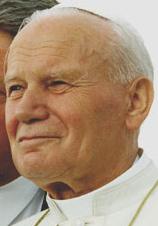Beatification

Beatification (from Latin beatus, blessed, via Greek μακάριος, makarios) is a recognition accorded by the Catholic church of a dead person's accession to Heaven and capacity to intercede on behalf of individuals who pray in his or her name (intercession of saints). Beatification is the third of the four steps in the canonization process. A person who is beatified is given the title "Blessed."
Contents |
History
The word "beatification" probably came in use after the fourth century when it was introduced in the church at Carthage, but the idea is older. In earlier ages this honor was entirely local and passed from one diocese to another with the permission of their bishops. This is clear from the fact that early Christian cemeteries contain paintings only of local martyrs. Some beatifications by bishops in the Middle Ages were almost scandalous by modern standards. For instance, Charlemagne was beatified by a court bishop soon after his death. He was never canonized, and his veneration has been mostly suppressed, though permission is given to celebrate Mass in his honor in the cities of Aachen and Osnabrück, but without using the title of "Blessed."
Since the Canon law reform of 1983, one miracle must be proven to have taken place through the intercession of the person to be beatified, though this requirement is waived for those who died a martyr. More about the process can be found in the article on canonization.
The feast day for the Blessed person is not universal, but is celebrated only in regions where the person receives particular veneration. For instance, Blessed Kateri Tekakwitha is honored in the United States of America and Canada. The person may also be honored in a particular religious order. For instance, veneration of John Duns Scotus is found in the Archdiocese of Cologne, Germany, and among the Franciscans, among other places.
Beatification practices under the Popes
Pope John Paul II (16 October 1978 — 2 April 2005) markedly changed previous Catholic practice of beatification. By October 2004 he had beatified 1,340 people, more than the sum of all of his predecessors since Pope Sixtus V (d. 1590), who established a beatification procedure similar to that used today. His successor, Pope Benedict XVI, removed the custom of holding beatification rites in the Vatican with the Pope presiding; they can now be held in the location where the subject lived with a Cardinal designated to preside over the ceremony.
Cultus confirmation
Cultus confirmation is a somewhat different procedure, where the church recognizes a local cult of a person, asserting that veneration of that person is acceptable. Such a confirmation is more of an official sanctioning of folk Christianity than an active step in a canonization procedure, but the object of the cult may equally be addressed as "Blessed".[1]
References
- Vatican website, with new procedures
- The Process of Becoming a Saint - article explaining the history of the process of becoming a saint at the Catholic Herald.
- "Beatification and Canonization". Catholic Encyclopedia.
See also
- List of blesseds
External links
- List of all Blesseds in the Catholic Church by Giga-Catholic Information.
This article incorporates text from the public-domain Catholic Encyclopedia of 1913.
| Stages of Canonization in the Roman Catholic Church |
|---|
| Servant of God → Venerable → Blessed → Saint |